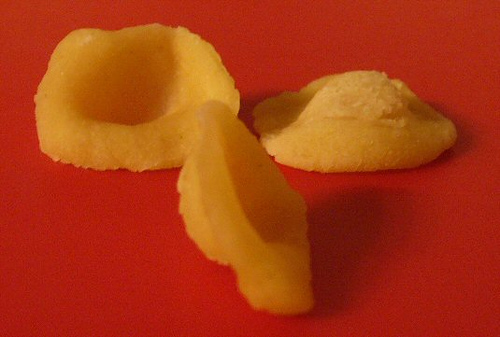Sometimes there’s nothing more enjoyable than a big bowl of pasta topped with tomato sauce and freshly grated Parmesan cheese from Italy. While it’s hard to decipher why we find this simple starch so addicting, it is certain that we aren’t the only ones who enjoy it. Pasta has been around for thousands of years, dating back to the Ancient Romans; however, the type of dough they used was baked instead of boiled. It wasn’t until the late first century that boiling pasta became the customary cooking method.
Dried pasta became popular in the early Middle Ages, especially with shipmates and explorers because of its long shelf-life and ability to feed large quantities. Around this time, various pasta shapes emerged across Italy because of new technologies and tools; however, many of the shapes were also handmade. According to Oretta Zanini de Vita in her book Encyclopedia of Pasta, “The range of shapes shows that cooking was a way of self-expression for women to show their creativity and imagination with little or no resources.” We don’t know exactly why some of these shapes were formed, but the different shapes served different purposes; each held the sauce or flavor in a unique way because of the curves and ridges.
Today, there are over 350 shapes and variations of pasta shapes. We have linguine, ravioli, spaghetti, and the like, but some of the more unique-shaped pastas have quirky and interesting origins. Let’s look!
Orecchiette
Orecchiette pasta originated from Puglia (the heel of Italy’s boot). Its small curved form, which sometimes even has the pasta-maker’s thumbprints on it, inspired the name meaning “little ears.” Orecchiette is great for chunky and heavy sauces because of its hollow shape that serves as a little bowl.
Penne and Torchietti
Naples has become more or less the pasta capital of Italy. Its agreeable climate and agricultural conditions make it a prime location to grow durum wheat—the most important element in quality Italian pasta. Naples is also home to the first pasta machine and four-pronged fork! Not only has it propelled the Italian pasta revolution, but it also is home to unique pasta shapes. Penne comes from this region of Campania. The way this pasta is cut on an angle resembles the tip of a quill, which is how it got its name meaning “pen” or “quill.” There are also several variations of penne: penne rigate (with ridges), pennette (smaller penne), and pennioni (bigger penne). Penne rigate holds more sauce because of its ridges, whereas smooth penne works better with an olive oil dressing. Penne is a tubular pasta, which means that it is a great pairing for thick tomato sauces, meat sauces, chunky vegetable sauces, and thick cream sauces.
Torchietti, “little torches,” also come from Campania. This bell-shaped pasta is traditionally served with plain tomato sauces.
Corzetti
Genoa and the region of Liguria probably has one of the most unusual pasta shapes: corzetti. This pasta resembles stamped coins and even displays family crests! In the early Middle Ages, serving corzetti with the crest was a display of wealth and status because a great deal of effort (from the servants of course) went into designing each piece. A hand-made wooden stamp was used to emboss the dough. The little divots created in the process held the sauce. If you want to make these delicacies for your next party, certain shops in Genoa still sell the wooden stamps emblazoned with flowers, trees, and other designs.
How do you serve these little coins? The earliest cookbooks of the eighteenth century paired corzetti with meat sauce, but now there are recipes that call for pesto or a light pine nut sauce.
Strozzapreti
Strozzapreti originated from the Tuscan and Romagna regions, bringing an interesting yet morbid history with it. Back in the day, priests could eat for free at restaurants and in people’s homes. The restaurant owners used to joke that they hoped the priest would choke on the pasta before the more expensive secondi piatti. This twisted pasta shape could get lodged in someone’s throat, leading to a fateful demise if not careful. The name strozzapreti literally means “priest stranglers”! Because of these dangerous twists, strozzapreti is a good pair for thick sauce. A typical Emilia-Romagnan strozzapreti dish is served with either a vegetable sauce, sausage ragu, or porcini mushrooms.
Tortellini, Farfalle, and Castellane
Even though Naples became the center for pasta, northern Italy and the region of Emilio-Romagna had an important role in providing us with some of our beloved pasta shapes and fun stories behind them! Tortellini’s history involves the Roman goddess of love, Venus. The myth states that the chef tried to steal a peek of the goddess through the keyhole to her room but all he saw was her belly button. As soon as he saw it, he rushed back to the kitchen and prepared tortellini, which resemble Venus’ navel.
Tortellini is a stuffed pasta (with anything from ground meat, ham, cheese, and spinach) that is traditionally served in a broth. It is also served with a light tomato or cream-based sauce. Because this pasta is already stuffed, lighter sauces work best!
In the 1500’s, farfalle, or “butterfly,” pasta was invented. Nowadays, we call it “bow-tie” pasta, but when it first originated, bow-ties had yet to be worn. Farfalle is a versatile pasta because it is thick enough for any sauce, and it can be added to salads or soups.
Along the coast of Italy, small crabs scuttled around the shoreline. The curled shells of these paguri inspired chefs to create this pasta. Later on, some noticed that these little shells also resembled the long skirts that the women of the Italian courts wore, and the name was changed from paguri pasta to castellane pasta, meaning “castle dwellers.” Traditionally, castellane pasta is served with a dairy-based or fish-based sauce.
What is your favorite kind of pasta and why?
—
Written by : Laura Photo Credits: jujuly25 / jdpage / elaine mccardel / fugzu / scottfeldstein






